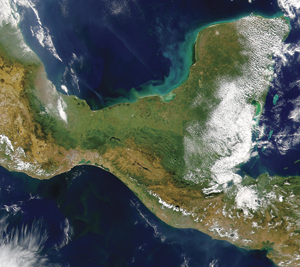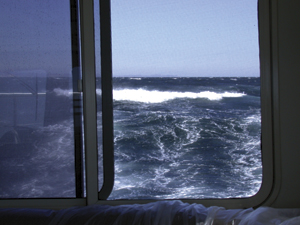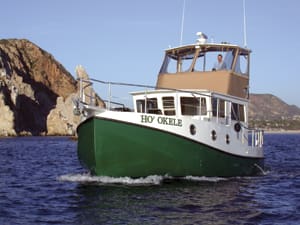The Mexican Navy warned us. We were chugging northward over the inky blue Pacific Ocean when a radioman on the patrol boat told of a gale forecasted for the Gulf of Tehuantepec.
I was working for the builder of Great Harbour trawlers at the time, and two of us were taking a Great Harbour N37 named Ho’Okele from Florida to Ensenada, Mexico, as part of a two-stage delivery to Hawaii.
In a moment of inspired audacity, the boat’s buyer and Great Harbour President Ken Fickett decided to deliver the boat to Hawaii on her own bottom. This unusual decision was due in part to conditions in late 2002 when these events occurred. A longshoreman’s strike at West Coast ports had run up shipping costs to the point where it was almost as cheap to drive the 7,000 miles from Florida to Honolulu. Diesel fuel back then was under $1.50 a gallon.
Money was a factor, but both the owner and the factory saw this Hail Mary delivery as an opportunity for bragging rights. A year earlier, Nordhavn had set the standard for adventure by sending one of its 40-footers on a successful journey around the world. Great Harbour wanted its turn at what I later dubbed “heroic marketing.”
I radioed back to the Mexican Navy that we were aware of the Tehuantepec storm and intended to keep “one foot on the beach” as we passed through. The radioman wished us well.
Waiting on the weather
My crew and I had been holed up with Ho’Okele at Marina Barillas in El Salvador over the New Year’s holiday. We were watching the weather to gauge when best to embark on a 475-mile run to a little resort town in the Oaxaca region called Santa Cruz. It didn’t look good. January sees Tehuantepec storms, or Tehuanos, an average of 19 out of its 31 days. We decided to press on regardless of the forecast.
 |
 |
|
Above, the Gulf of Tehuantepec, on the Pacific side of the Isthmus of Tehuantepec, can have gale-force winds. These winds produce steep waves that grow as they head offshore. Below, waves seen from Ho’Okele. |
The meteorological chain of events that causes Tehuanos is straightforward. In winter, cold high-pressure systems roll southward from Texas over the Gulf of Mexico, creating pressure gradients that generate winds through a pass in Mexico’s mountains leading to the Gulf of Tehuantepec. Counterintuitively, Tehuanos produce waves coming out from land, not crashing against it. To avoid the awful square waves that result, a vessel must transit within a half mile of shore.
Our contact with the Navy had happened around 0830. By mid afternoon, winds had whipped up to 35 knots. Entering the storm in daylight gave me the chance to work out a system for keeping a consistent half-mile out that could be applied once the sun had set. The chartplotter’s cartography was faulty for this section of Mexico, as the plotter displayed Ho’Okele’s position more than a quarter mile inland. We would rely on radar to keep our interval that night.
As predicted, the chop close to the beach was only one to two feet, but that did not mean a dry ride. Increasing to more than 40 knots, the howling north wind snatched the tips of these waves and hurled them against our starboard side. It was like driving through half a car wash. And the darkness was utter. No moon, no stars, no light ashore — nothing but black and brine.
Tired and cold, but never wet
We wore sweaters as we alternated two-hours on, two-hours off at the helm, piloting by radar and sounder alone. We were tired and cold, but never wet. The pilothouse provided a comfort zone that would have been impossible in, say, my 41-foot sailboat. Even though her cockpit is enclosed in canvas and isinglass, the Tehuano’s pressure-washer effect would have driven water through the little gaps at the end of the zippers and through the needle holes along the seams.
On my sailboat, the howling wind and rattling rigging would have added to our stress and fatigue. Instead, those sounds were masked by twin Lugger diesels beating beneath our feet. The trawler’s pilothouse and excellent Furuno radar, made possible what otherwise might have seemed a foolhardy endeavor.
Our only crisis was nearly going aground at a berm formed at the mouth of a lagoon. Seeing the sounder count down, I turned the boat sharply to port and found deeper (and rougher) water, then gradually crept back to the Tehuantepec lee. Following the curve of the coast and with waves from astern, we enjoyed a fine ride.
A few weeks later, we pulled into Ensenada just in time to watch the Super Bowl. In March, another crew took Ho’Okele to her destination, carrying an additional 500 gallons of diesel in auxiliary tankage. Their passage was without incident and took two weeks, nearly to the minute. The crew caught a few fish; otherwise the ride was monotonous, but the transit did set a niche record for smallest twin-screw power cruiser to ever make the 2,200-mile passage.
Peter Swanson is a delivery captain with a 50-ton license, and a marine writer specializing in Cuba’s coast as a potential cruising ground.

